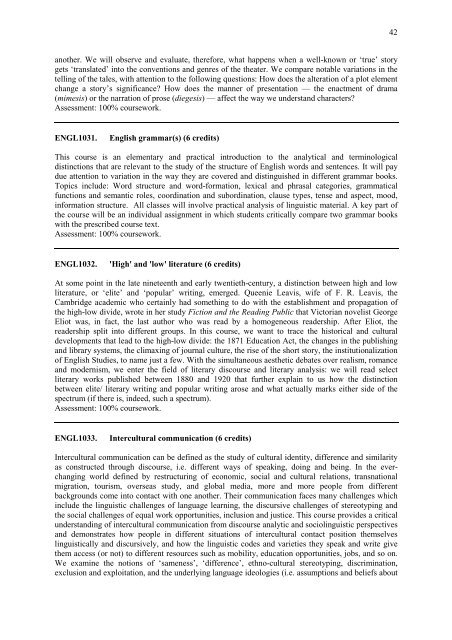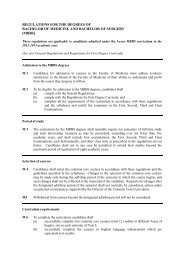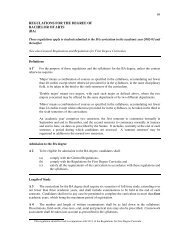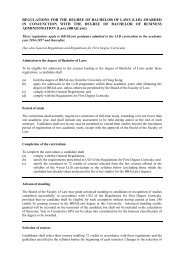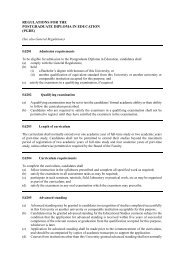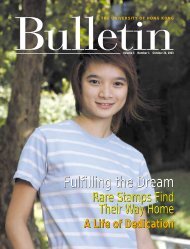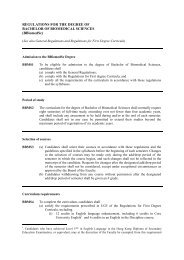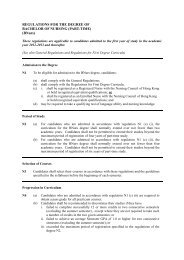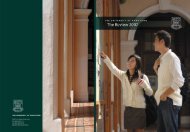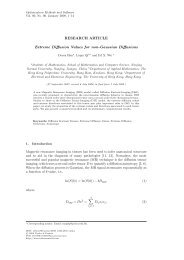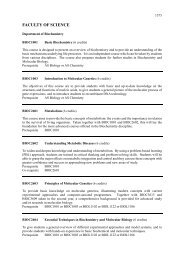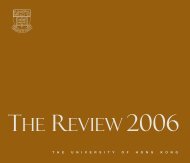(BA) (4-year-programme) - The University of Hong Kong
(BA) (4-year-programme) - The University of Hong Kong
(BA) (4-year-programme) - The University of Hong Kong
You also want an ePaper? Increase the reach of your titles
YUMPU automatically turns print PDFs into web optimized ePapers that Google loves.
42another. We will observe and evaluate, therefore, what happens when a well-known or ‘true’ storygets ‘translated’ into the conventions and genres <strong>of</strong> the theater. We compare notable variations in thetelling <strong>of</strong> the tales, with attention to the following questions: How does the alteration <strong>of</strong> a plot elementchange a story’s significance? How does the manner <strong>of</strong> presentation — the enactment <strong>of</strong> drama(mimesis) or the narration <strong>of</strong> prose (diegesis) — affect the way we understand characters?Assessment: 100% coursework.ENGL1031.English grammar(s) (6 credits)This course is an elementary and practical introduction to the analytical and terminologicaldistinctions that are relevant to the study <strong>of</strong> the structure <strong>of</strong> English words and sentences. It will paydue attention to variation in the way they are covered and distinguished in different grammar books.Topics include: Word structure and word-formation, lexical and phrasal categories, grammaticalfunctions and semantic roles, coordination and subordination, clause types, tense and aspect, mood,information structure. All classes will involve practical analysis <strong>of</strong> linguistic material. A key part <strong>of</strong>the course will be an individual assignment in which students critically compare two grammar bookswith the prescribed course text.Assessment: 100% coursework.ENGL1032.'High' and 'low' literature (6 credits)At some point in the late nineteenth and early twentieth-century, a distinction between high and lowliterature, or ‘elite’ and ‘popular’ writing, emerged. Queenie Leavis, wife <strong>of</strong> F. R. Leavis, theCambridge academic who certainly had something to do with the establishment and propagation <strong>of</strong>the high-low divide, wrote in her study Fiction and the Reading Public that Victorian novelist GeorgeEliot was, in fact, the last author who was read by a homogeneous readership. After Eliot, thereadership split into different groups. In this course, we want to trace the historical and culturaldevelopments that lead to the high-low divide: the 1871 Education Act, the changes in the publishingand library systems, the climaxing <strong>of</strong> journal culture, the rise <strong>of</strong> the short story, the institutionalization<strong>of</strong> English Studies, to name just a few. With the simultaneous aesthetic debates over realism, romanceand modernism, we enter the field <strong>of</strong> literary discourse and literary analysis: we will read selectliterary works published between 1880 and 1920 that further explain to us how the distinctionbetween elite/ literary writing and popular writing arose and what actually marks either side <strong>of</strong> thespectrum (if there is, indeed, such a spectrum).Assessment: 100% coursework.ENGL1033.Intercultural communication (6 credits)Intercultural communication can be defined as the study <strong>of</strong> cultural identity, difference and similarityas constructed through discourse, i.e. different ways <strong>of</strong> speaking, doing and being. In the everchangingworld defined by restructuring <strong>of</strong> economic, social and cultural relations, transnationalmigration, tourism, overseas study, and global media, more and more people from differentbackgrounds come into contact with one another. <strong>The</strong>ir communication faces many challenges whichinclude the linguistic challenges <strong>of</strong> language learning, the discursive challenges <strong>of</strong> stereotyping andthe social challenges <strong>of</strong> equal work opportunities, inclusion and justice. This course provides a criticalunderstanding <strong>of</strong> intercultural communication from discourse analytic and sociolinguistic perspectivesand demonstrates how people in different situations <strong>of</strong> intercultural contact position themselveslinguistically and discursively, and how the linguistic codes and varieties they speak and write givethem access (or not) to different resources such as mobility, education opportunities, jobs, and so on.We examine the notions <strong>of</strong> ‘sameness’, ‘difference’, ethno-cultural stereotyping, discrimination,exclusion and exploitation, and the underlying language ideologies (i.e. assumptions and beliefs about


